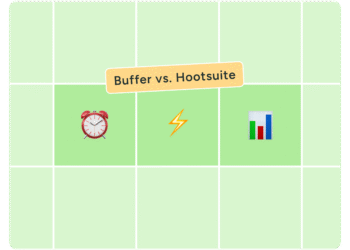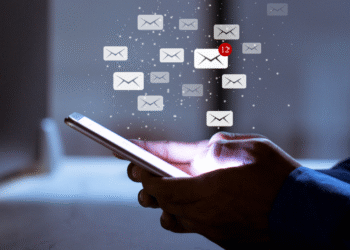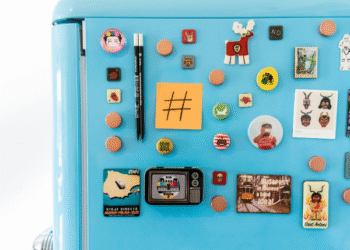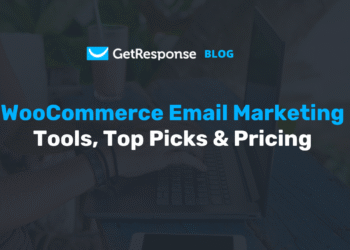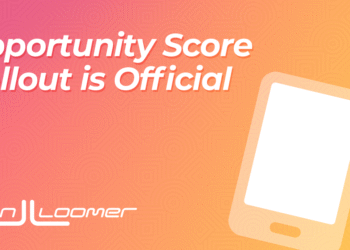Shopify automation allows you to set up various workflows that are triggered based on what customers do on your Shopify store. For example, you can set up a trigger to deploy a cart abandonment email series when a customer abandons their shopping cart.
Shopify marketing automation is one of the most effective ways to engage your customers without wasting resources on manual interactions. It can also help you generate more revenue through automated workflows like upsells, cross-sells, and abandoned cart recoveries.
This article will cover ten important automation workflows every Shopify store needs and how to set them up. But first….
Automate your Shopify store for maximum revenue
Discover how Shopify automation can help you engage customers automatically and generate more sales through smart workflows. Learn the essential automations every online store needs to succeed.
What is Shopify automation?
Shopify automation is the use of built-in or third-party tools to automate various repetitive tasks, especially related to marketing and customer engagement. Shopify provides an inbuilt automation platform that can help you set up automation workflows to engage buyers at different stages of the customer journey.
However, these inbuilt marketing automation tools have various limitations, which push Shopify store owners to integrate apps from third-party providers. These Shopify automation applications support advanced targeted email campaigns through tailored audience segments, for example.
How does Shopify marketing automation work
Shopify automations use triggers you’ve set to send specific email communications depending on user actions on your store. The platform lets you build custom automations and provides pre-built automation templates for some of the most common customer communications.
For example, it has a prebuilt welcome email series, abandoned cart recovery, abandoned product browse, and first purchase upsell automation templates.
The automations start with the specific trigger you set. For example, a welcome email series will be triggered when a new subscriber signs up for your newsletter. An abandoned cart email series will be deployed when a user abandons their cart instead of completing an order. You get the idea.
After the trigger, you’ll set the condition which confirms that the user has taken the relevant action. This condition can prevent embarrassing scenarios like sending a user a welcome email with a discount when they’ve just completed their first order. So, new users who join your email list after completing their first order are excluded from the welcome series.
Finally, you have the action. This is where you specify the specific action, i.e., the type of email to be sent when the right triggers and conditions are met. Shopify provides a simple email editor where you can write your emails, apply specific discounts, and share your best-selling products.
Here is a visualization of the welcome automation workflow.
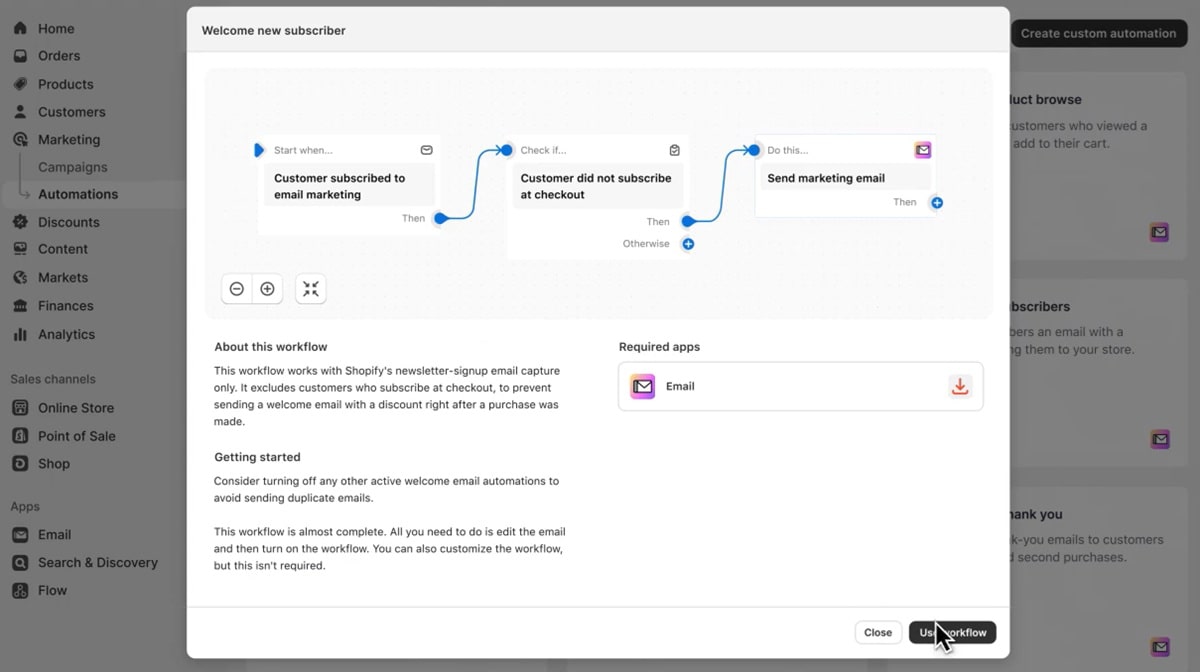
Once you’ve turned on the workflows to activate them, you’ll be able to monitor the performance of these automations from the admin dashboard under automations. You can track reach, sessions, conversion rates, and sales from this dashboard.

10 important Shopify automation workflows
Here are ten automation workflows you should use to engage customers and drive more sales.
1. Welcome email
Shopify’s inbuilt automation platforms allow you to set up three types of welcome email workflows.
First, you can set up an automated email sequence workflow to welcome new subscribers. This workflow will consist of three emails, starting with a warm welcome email offering a discount. That email will be followed by two brand-building emails. In case the customer doesn’t make a purchase from your store after the three emails, a fourth reminder email will be deployed to remind the customer of the welcome discount.
The second type of welcome workflow uses both email and SMS. This workflow lets you send several emails and SMS messages to welcome new subscribers.
Finally, you can set up a simple welcome workflow that sends new subscribers only one email with a welcome discount.
2. Abandoned cart
Abandoned cart recovery reduces the amount of money your Shopify store loses from customers who fail to complete their orders. This email workflow will track users who add products to their carts but do not check out.
It’ll then deploy a series of emails to convince the shopper to return and complete their orders. The emails can include incentives, such as discounts, to encourage customers to place their orders.
Alongside the abandoned cart email workflow, you can also set up an abandoned checkout workflow, which tracks shoppers who add items to their cart and proceed to checkout but abandon the process.
3. Abandoned product browse
This workflow tracks users who browse items in your store but do not place any orders. The automation will look at the product page the user visited and send an automated email related to that product.
This automated email campaign can be very effective at boosting sales. It usually includes social proof and incentives like free shipping and discounts to increase sales.
4. First-purchase upsell
The first-purchase upsell automation workflow is sent a few days after the customer places their first order. The workflow promotes other best sellers in your store and may include special discounts, flash sales, and offers.
5. Post-purchase thank you
Shopify’s post-purchase thank-you email is sent after the customer has completed their first and second orders. The email thanks customers for buying from your online store.
You can also use third-party email automation platforms to ask for product reviews through these thank-you emails.
6. Back in stock
The back-in-stock workflow notifies customers that the products they showed interest in have been restocked and are now available.
7. Customer winback
Customer winback or customer reengagement campaigns target previous customers who have not bought anything from your store in a while.
Shopify’s built-in winback workflow allows you to target customers who haven’t made a purchase in 60 days. Third-party apps can provide more flexibility as to how many days the winback workflows should be deployed.
8. Birthday and anniversary emails
Third-party email marketing automation tools can track your customers’ birthdays and key anniversaries (like when they first bought from you) and deploy special birthday and anniversary emails.
Include exclusive discounts in these emails to make your customers feel special.
9. Product upsells and cross-sells
Shopify’s first-purchase upsell workflow sends an upselling email 14 days after a customer’s first purchase.
Third-party automation apps offer more flexibility for upsell and cross-sell campaigns. You can create dedicated upsell and cross-sell emails or include these offers within existing emails, like order confirmations and thank-you emails.
10. Customer feedback requests
The customer feedback workflow is deployed a few days after the customer has received their order. The email can request a product review for the item they bought or overall feedback to help you enhance the customer experience.
Which Shopify automation workflow has been most effective for your store – abandoned cart recovery, welcome series, or customer winback campaigns?
How to set up Shopify automation
Before setting up Shopify automation, you will need at least the Basic Shopify plan. You must also install the Shopify Flow app and the Shopify Forms app to use with workflows like the welcome email automation.
Now, follow these steps to build marketing automation workflows on Shopify:
Step 1: Log in to your Shopify account as an administrator and then navigate to Marketing and Automations.
Step 2: Click the “Create Automation” button.
Step 3: Several pre-built automation templates will appear. Select the appropriate one or choose to create a custom automation.
Step 4: Once you’ve selected the template, customize it by selecting the trigger and conditions. These will depend on the automation campaign you want to build. For example, a new subscriber signing up for your newsletter will be the trigger for your welcome automation.
Step 5: Use the Shopify email editor to write the automated email.
Step 6: Click “Turn On Workflow” to activate the automation.
Best Shopify marketing automation apps
Third-party marketing automation apps help you tailor your interactions and marketing efforts based on customer behavior. Some of these apps also unlock additional functionalities like web push notifications, live chats, and landing page builders.
| Tool | Key features | Starting price |
| GetResponse | AI‑powered product recommendations & upsell/cross‑sellCustomizable templatesTransactional emailsDrag‑and‑drop editorPromo‑code management & dedicated IP | $119/mo |
| Klaviyo | AI‑driven triggers & segmentationPrebuilt automation templatesRevenue‑per‑flow/campaign analyticsPop‑ups & forms builder | $45/mo (pricing also tiers by sends and contacts) |
| Omnisend | Prebuilt workflows (e.g., cart recovery, welcome series)Professional templatesSmart segmentationAutomated A/B testing | $16/mo for 500 contacts (6,000 emails) |
| Mailerlite | Behavior‑based tracking (forms, clicks, site visits)Personalized, trigger‑based email workflowsMulti‑trigger automations (up to 3 triggers per workflow)A/B test up to 3 workflows | $27/mo for 1,000 contacts (unlimited templates + multi‑trigger) |
| Mailchimp | Multi‑channel automations (email, SMS, mobile push, social ads)60+ prebuilt workflow templatesTransactional emails via add‑on (order confirmations, shipping, password resets)Dynamic content personalization | $13/mo for 500 contacts (up to 4 workflow steps) |
| Brevo | Drag‑and-drop workflow builder Automated lead scoring and product recommendationsAdvanced behavioral segmentation | $16.17/mo for 500 contacts & 5,000 monthly sends |
Here is a breakdown of the six best apps for marketing automation on Shopify.
11. GetResponse
GetResponse is a marketing automation platform with a seamless one-click integration with Shopify. You can install the GetResponse app from the Shopify app store and start creating your automation workflows straight away.
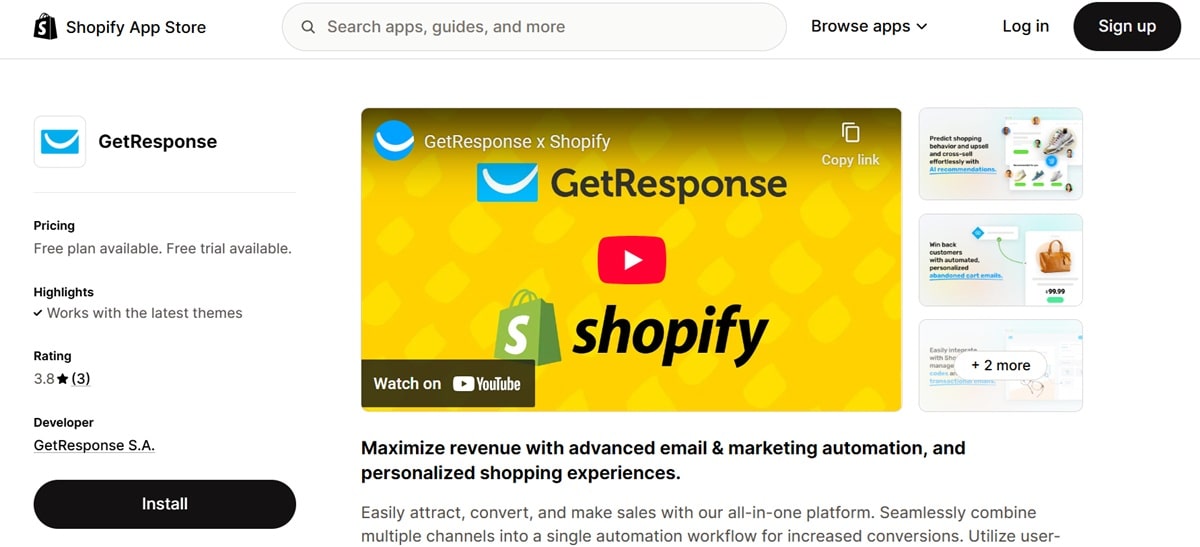
The GetResponse and Shopify integration allows you to import data like customer information, product catalog, customer’s order information, and the sites they visit. You can then use this customer data to build personalized automation workflows.
For example, GetResponse lets you track and segment customers based on their purchase history. The platform will then target these customers with relevant email product recommendations to boost sales.
Our platform can also send personalized product recommendations based on individual preferences as implied by the product pages a user browses.
In fact, Eveline Cosmetics used GetResponse’s Max to set up powerful email marketing campaigns with advanced automations. The beauty store generated $13,000 in sales in a single month from one email campaign. Product recommendations worth $7,000 were added to the cart through this email campaign.
You can learn more about the case study here.
The GetResponse Shopify app gives you access to lots of customizable email templates, too. We have templates for various automation campaigns like cart abandonment, upselling and cross-selling campaigns, customer re-engagement, post-purchase follow-ups, Thanksgiving, and Black Friday, among others.
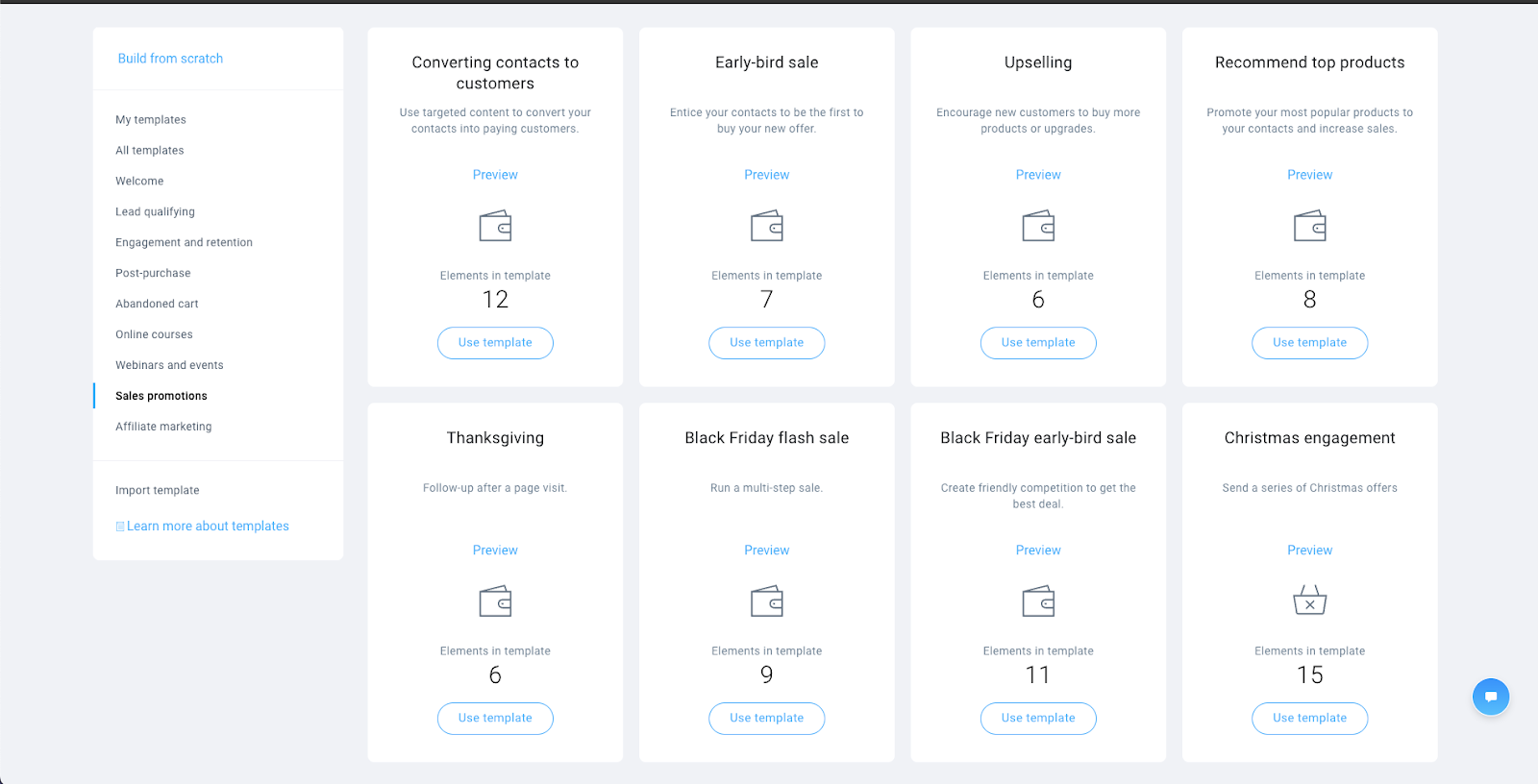
You can also use the data from your product catalog to create sales funnels, as well as track your best sellers and use them in your product recommendation emails.
Key features
- Comes with AI recommendations that can predict shopping behavior and identify upselling and cross-selling opportunities
- Supports key transactional emails like order confirmation, shipping confirmation, delivery confirmation, password reset, and account notifications
- Supports marketing efforts across other channels beyond email, like SMS, push notifications, landing pages, and paid ads.
- Helps you manage promo codes conveniently and get a dedicated IP to optimize email engagement and deliverability.
- Intuitive drag-and-drop email editor for faster email creation.
Pricing
GetResponse has a free plan, but it limits you to only 500 contacts. This plan also has limited eCommerce features. You’ll get more value upgrading to our eCommerce package, which costs $119/mo for 1,000 contacts. This plan gives you access to unlimited email sends, abandoned cart recovery, product recommendations, transactional emails, web push notifications, and revenue reports. You can try the plan for free for 30 days.
For large stores, the GetResponse Max gives you maximum performance with features like dedicated IP, users & role management, and priority support and onboarding. This plan costs $1,099 per month.
Supercharge your Shopify store with GetResponse
Connect your Shopify store with GetResponse in one click and start building powerful automation workflows. Get AI-powered product recommendations, advanced segmentation, and proven templates that drive results.
12. Klaviyo
Klaviyo is a well-known marketing platform that can also be integrated with your Shopify store. The platform supports marketing across multiple channels, including email, SMS, and WhatsApp.
Klaviyo’s automation features support key campaigns, including price drop alerts, back-in-stock notifications, abandoned cart reminders, and welcome emails.

Key features
- Easy-to-use email editor with a decent selection of templates.
- Lets you use historical and real-time customer data to create AI-powered triggers and customer segments.
- Delivers real-time data on revenue per automation, campaign, or segment.
- Helps you build interactive forms and popups to capture email addresses.
Pricing
Klaviyo offers a free plan that supports up to 250 contacts and 150 SMS/MMS credits. Paid plans start at $45 per month for email campaigns. This plan supports up to 15,000 emails. This is a significant difference from GetResponse, where pricing is only based on your contact list size. Klaviyo pricing varies based on both the size of your contact list and the number of emails you send.
13. Omnisend
Omnisend is another big name in the email marketing industry. The platform supports the marketing automation of both email and SMS marketing campaigns to help you reach customers where they are. You can also install the Omnisend app directly from the Shopify app store.
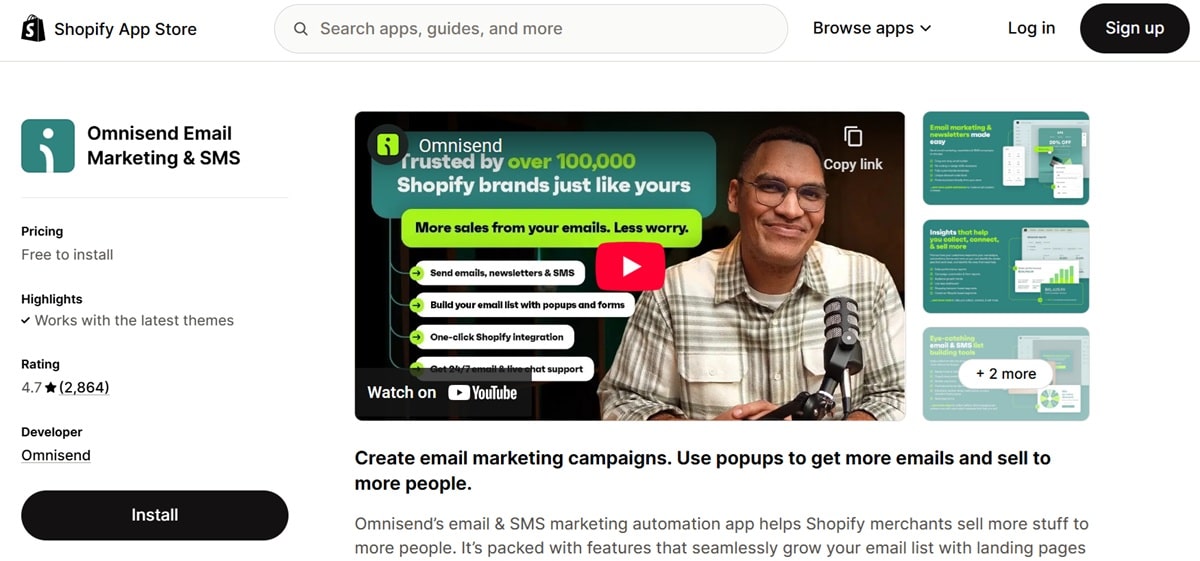
The app helps you build your email list through sign-up forms and pop-ups. It also offers a landing page creator and pre-built email templates.
Omnisend supports various eCommerce marketing automation workflows to eliminate manual tasks and save time. Some of these workflows include abandoned cart recovery, follow-up emails, and welcoming new subscribers.
Key features
- Comes with prebuilt workflows and automations
- Professional email templates for Shopify email marketing
- Smart audience segmentation suggestions
- Supports automated A/B testing
Pricing
Omnisend’s free plan supports up to 250 contacts and 500 emails per month. Though the free plan comes with prebuilt workflows and automations, the cap on contact list and email sends makes it ideal for a small business.
That means you’ll need to upgrade to the paid plans, which start at $16/month. This allows you to send 6,000 emails per month, but your contact list size is capped at 500. You’ll need to spend at least $59/mo to reach 2,500 contacts and send unlimited emails.
14. Mailerlite
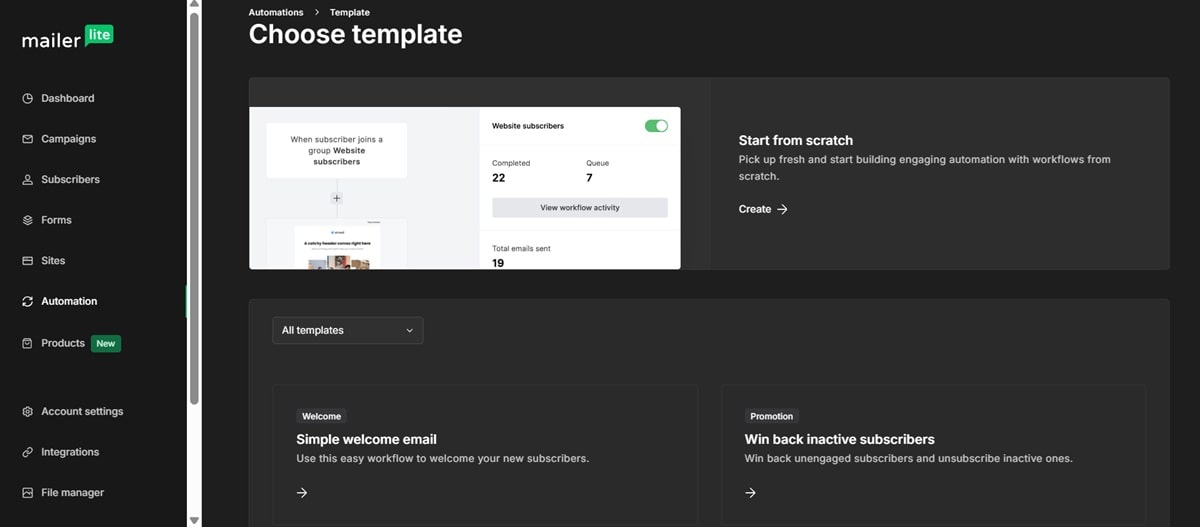
Mailerlite’s marketing automation platform allows you to respond to every customer action on time. The platform tracks customer behavior on your site, like submitting a form, joining your newsletter, and even the links they click in your emails. It then uses that data to send personalized emails to nurture leads through the customer journey.
Mailerlite also supports multi-trigger automation, where you can use up to three different triggers to deploy the same workflow.
Let’s say you want to build a workflow that targets users who show interest in a product but haven’t bought it. You can create two different triggers to activate this workflow. One trigger would be for prospects who add items to a wish list. The next would be for prospects who browse and abandon the site.
Multi-trigger automations add efficiency and can help you avoid automation overlaps.
Key features
- Let’s you A/B test up to 3 workflows
- Integrates with Shopify, WooCommerce, Stripe, WordPress, and Make to power your automations.
- Provides automation history, where you can view and restore past workflows.
Pricing
Mailerlite provides automation features on its free plan, but with limitations. For example, you get very limited email automation templates on the free plan. Even the low-tier ‘Growing Business’ plan has limited templates.
You’ll need to spend $27/mo (for 1,000 email contacts) on the Advanced plan to access unlimited email automation templates and the multi-trigger automation feature.
15. Mailchimp
Mailchimp supports eCommerce automations across multiple channels, including email, SMS, mobile push notifications, and social media. The platform provides more than 60 prebuilt automation workflow templates. This includes workflows for popular eCommerce campaigns like welcome series, cart abandonment, and back-in-stock notifications.
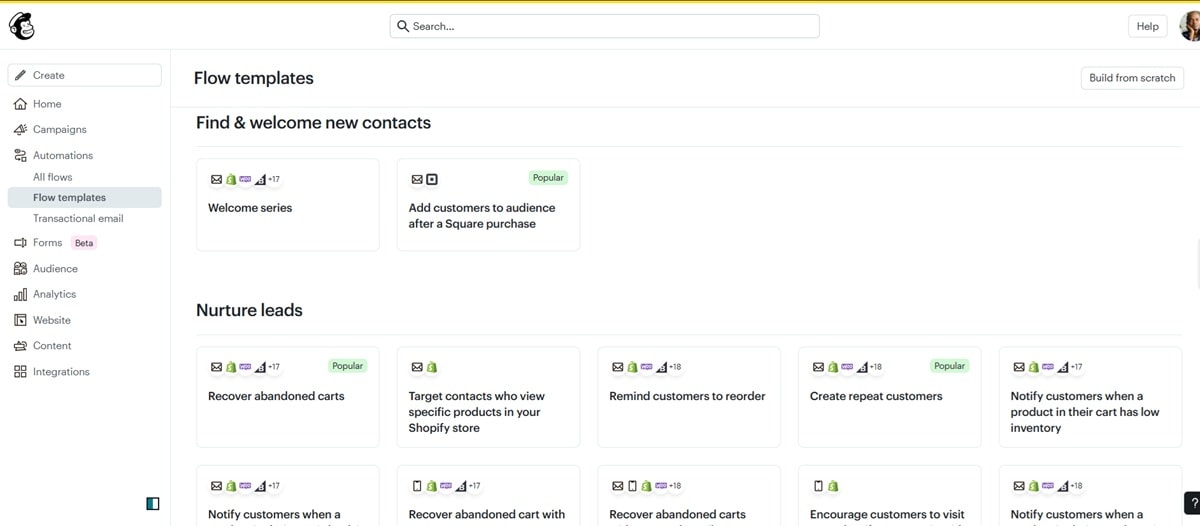
Mailchimp also offers transactional services, which help you automate transactional emails, such as order confirmations, shipping and delivery confirmations, and password resets.
Like GetResponse, Mailchimp’s transactional email service is offered as an add-on you pay for separately. You’ll need either the Standard or Premium Mailchimp plan to add the transactional emails service.
Key features
- Mailchimp’s Campaign Manager helps you manage campaigns across different channels in one place.
- Personalize emails automatically through dynamic content
- Supports automated personalized retargeting campaigns based on users’ activities on your site.
- Supports over 300 integrations
Pricing
Mailchimp’s basic automation features are accessible from the cheapest Essential plan, which costs $13/mo for 500 contacts. This plan supports up to 4 automation flow steps.
The Standard plan provides the best value. It accommodates up to 200 flow steps and includes predictive segmentation, advanced segmentation, and behavioral targeting. This plan costs $45/mo for 1,500 contacts.
16. Brevo
Brevo is another platform that supports cross-channel marketing automations. You can use it to automate your SMS, email, and WhatsApp campaigns.
The automation tool features a simple drag-and-drop editor where you can customize the automation workflows. It provides a decent selection of pre-made templates to speed up your workflow creation process. You’ll also have the option to build your own workflows from scratch with custom triggers and conditions.
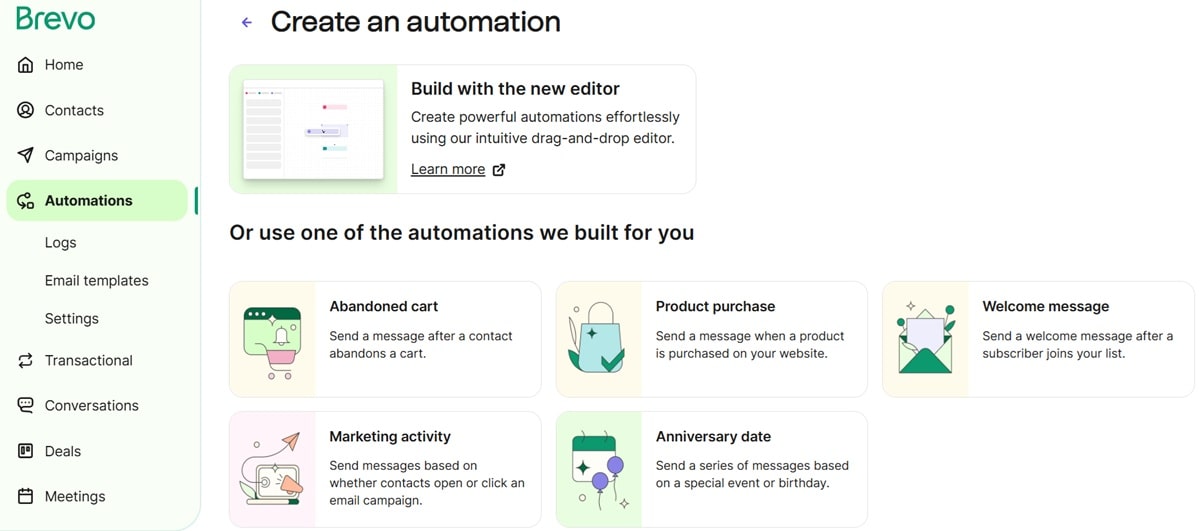
Brevo automates lead scoring and product recommendations as well.
Key features
- Supports advanced segmentation based on activities like campaign interactions.
- Integrates with 150+ eCommerce, CMS, and CRM tools
- Offers AI-powered predictive email sending
- Supports dynamic email content
Pricing
Automation features are available on Brevo’s free plan. However, your contact list is limited to 2,000 emails. You’ll need the business plan, which starts at $16.17/mo, to run unlimited automation campaigns. That price accommodates only 500 contacts and 5,000 monthly email sends.
You’ll pay $35/mo to send 10,000 emails to 1,500 contacts. This also gives you 500 credits for push notifications.
That’s one of the key differences between Brevo and our platform, GetResponse. Brevo’s pricing will always vary based on the contact list size and monthly email sends. GetResponse gives you unlimited monthly email sends. The price tag is based solely on your list size.
What’s your biggest challenge with Shopify automation – setting up workflows, choosing the right app, or measuring performance?
Scale your Shopify success with powerful automation
Ready to automate your Shopify store and boost revenue? Start with GetResponse’s proven automation platform that includes AI-powered recommendations, advanced segmentation, and seamless Shopify integration.
In closing
Shopify automation allows you to automate critical yet repetitive marketing tasks so that your online store can generate sales on autopilot. Beyond reducing manual effort, investing in powerful Shopify marketing automation software helps you engage customers at key points in their journey.
The GetResponse app can help with transactional emails, for example. These emails keep customers informed about their orders and account activities.
Automation apps also provide more marketing capabilities like landing page builders, web push notifications, and pop-up and form builders. Plus, they support large stores through features like dedicated IP addresses and user and role management.
Start by identifying the automation workflows your store needs. The list of the ten crucial automation workflows we’ve shared above is a good place to start. Then, identify the right marketing automation software to build and deploy these workflows.


